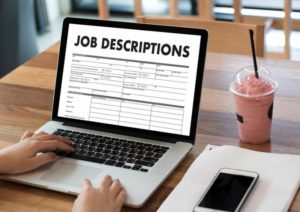
Writing clear and compelling job descriptions is an important element of recruiting that can help you attract the most qualified candidates for your job openings. With more than 20 million jobs listed on Indeed for Employers (see How to Write a Job Description), a well written job description can help your job openings stand out from the rest.
The key to writing effective job descriptions is to find the perfect balance between providing enough detail so candidates understand the role and your company while keeping your description concise. Catherine Conlan, writing for Monster job website (How to Write a Job Description That Finds You Great Candidates), advises that you keep your job description simple and clear. This will increase the likelihood that job seekers will read it from top to bottom and come away with a clear understanding of the job. Conlan says that job descriptions between 700 and 2,000 characters get up to 30% more applications.
There are some key components of an effective job description that will attract the right candidates for your business (see Tri-Valley Career Center’s Writing a Job Description Tip Sheet). Follow a logical format, starting with the job title and ending with a call to action.
- Job Title
The first fundamental element of the job description is the job title. Consider it carefully. Some job titles may have many different interpretations of what the role actually is, especially if it is unique or specific to a certain sector. The working title for a job should be based on the main function or role of the job. It is important to stay away from both vague and overly specific job titles. Avoid “made-up” titles that include uncommon words which will negatively impact your job’s ranking in search results. Create a working title that appropriately describes both the level of responsibility and role of the job. - Summary
This is your opportunity to communicate your company’s value proposition. What exactly does your business do, and what makes you special? Tailor your pitch to your ideal candidate so they can imagine what it will be like to work for your company. The summary should contain 2-4 sentences. Include some information on the position’s relationship to others, reporting lines, and/or if it’s part of a larger team. This is important, not only in relation to compliance issues, but also to provide insight into the hierarchical structure of the organization. - Responsibilities
Think of this as a high-level overview of the job’s main responsibilities that will help the job seeker know if the position is right for them. Include relevant keywords to help your posting be found in search results. - Requirements/Preferences
Requirements are the “must-haves” for the applicant to get the job; preferences are the “nice to have” qualities. Providing both will help candidates gauge how their own skills and experiences measure up to your vision of a superstar employee. Be specific about the skills and education that are required for the role and where there’s some flexibility. Do not over reach the “must-haves”. If a position does not require a college degree, do not include it in this section. Then, be open to talk with candidates who meet those qualities. - Compensation and Benefits
Give some kind of salary range and general benefits. Many organizations are reluctant to do this in a job posting, but organizations that post salary information generally get applicants who are better qualified and genuinely interested in the position. Include primary benefits (healthcare, 401k, etc.) as well as secondary benefits that are unique to your company (flexible work options, child care support, etc.) These will help set your company apart from the competition. - Call to Action
Be specific about what you want candidates to provide and where or how you want them to send it. If you prefer that they apply with a code or to a specific person, be clear with those instructions. This is also true if you want specific information included in the candidate’s application, such as a sample of previous work, references, salary history or a cover letter.
Put yourself in the reader’s place. Look at the whole description from the job seekers’ point of view. Is it compelling and interesting? Does it describe your company well? Does it describe the position well? Is it clear, and are your expectations for the employee easy to understand? If the job seeker is unfamiliar with your company, will they discern your company culture and how this position fits into the company? Can they compare it to other jobs in the industry or to a related job title?
As you write your job description, keep your ideal applicant in mind. Provide enough information and description to help him or her visualize themselves in the position. The better you can articulate your desired characteristics and experience, the more targeted potential candidates will be.
An engaging job description will go a long way to help you attract the talent you need to grow and sustain your company.
